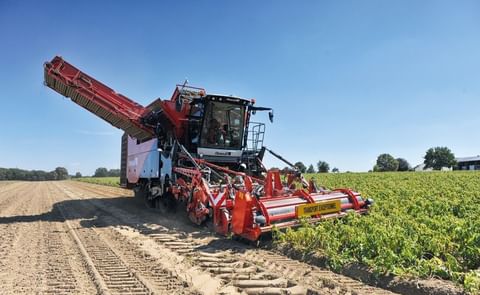Potato cultivation is a dynamic agricultural process that combines traditional knowledge with modern agronomy to produce one of the world’s most important food crops. Success in potato farming depends on careful attention to soil, climate, water, pest management, and harvesting techniques, ensuring both high yields and quality tubers for diverse markets.
Klik hier om uit te vouwen en meer te weten te komen!
Site Selection and Soil Preparation
- Soil Requirements: Potatoes thrive in loose, well-drained soils such as sandy loam or loam, rich in organic matter. Soils should be friable and porous to allow tuber expansion and prevent waterlogging, which can cause rot and misshapen tubers.
- pH and Fertility: The ideal soil pH ranges from 5.2 to 6.4. Acidic to neutral soils are preferred, as alkaline soils increase the risk of diseases like common scab.
- Preparation: Deep tillage (20–31 cm) and the addition of organic matter or compost several weeks before planting help create optimal conditions. Raised beds are recommended for poorly drained soils.
Climate and Growing Conditions
- Temperature: Potatoes perform best in cool climates, with optimal daytime temperatures of 18–29°C and night time temperatures of 13–18°C. Excessive heat or frost can reduce yield and tuber quality.
- Sunlight: At least six hours of direct sunlight daily is necessary for healthy growth and tuber development.
- Altitude: The crop can be grown up to 3,000 meters above sea level, adapting as a summer crop in hills and a winter crop in tropical and subtropical regions.
Planting Material and Method
- Seed Potatoes: High-quality, disease-free seed potatoes are essential. Tubers or cut pieces with viable "eyes" are planted 15–20 cm apart at a depth of 5–7 cm, depending on variety and field conditions.
- Seed Rate: The amount of seed used varies with tuber size and variety, typically ranging from 1.5–2.88 tons per hectare.
- Spacing: Proper spacing ensures uniform growth and maximizes yield potential.
Irrigation and Water Management
- Water Needs: Potatoes require 500–700 mm of water over a 120–150 day growing cycle, with increasing demand during tuber bulking.
- Irrigation Systems: Drip, sprinkler, and overhead irrigation are commonly used. Soil should remain consistently moist but not waterlogged; over-irrigation can lead to disease and nutrient leaching.
- Scheduling: More frequent irrigation is needed in sandy soils and during dry spells, while heavy soils hold moisture longer.
Crop Care and Nutrient Management
- Fertilization: Balanced application of nitrogen, phosphorus, and potassium supports healthy growth. Organic amendments improve soil structure and fertility.
- Hilling: Regular hilling (covering shoots with soil) protects developing tubers from sunlight, prevents greening, and encourages higher yields.
- Crop Rotation: Avoiding repeated potato cultivation in the same field helps reduce pest and disease buildup.
Pest and Disease Management
- Integrated Strategies: Use of resistant varieties, crop rotation, clean seed, and encouragement of natural pest predators are key practices.
- Major Threats: Pests like Colorado potato beetle, tuber moth, and nematodes, along with diseases such as late blight, bacterial wilt, and viruses, can significantly impact yield if not managed proactively.
Harvesting and Post-Harvest Handling
- Timing: Potatoes are harvested after vines die back and skins have set, usually a few weeks after flowering or foliage yellowing. Early harvesting results in immature potatoes with poor storability.
- Techniques: Mechanical harvesters or careful manual digging are used to avoid tuber injury. Pre-harvest vine killing helps toughen skin and extend storage life.
- Storage: Proper curing and storage in cool, dark, and well-ventilated conditions preserve tuber quality and reduce losses.
"Potato cultivation is a multifaceted process that requires careful management of soil, water, climate, and crop health. By integrating best practices and modern technology, farmers can achieve high yields and quality, supporting food security and meeting market demands worldwide.."
Explore Aardappelteelt Producten

R2060 Trailed 2-row sieving harvester
De R2060 is een echte capaciteitsmachine in het segment van de 2-rijige getrokken
zeefbandrooiers. De rooier is beschikbaar in 4 verschillende uitvoeringen, waarbij u dekeuzekanmaken tussen een reinigingsunit en/of doorvalmat.
zeefbandrooiers. De rooier is beschikbaar in 4 verschillende uitvoeringen, waarbij u dekeuzekanmaken tussen een reinigingsunit en/of doorvalmat.

Kwatro Sieving Harvester
De Kwatro is een zelfrijdende 4-rijige zeefbandrooier die frontaal rooien combineert met een klassieke zeefweg, egelband, reinigingsmodules én dit met de grootste bunker op de markt.
Browse Companies Offering Aardappelteelt

M S International
M S group started its journey in 1960 from a small village side grocery store. They have expanded with time and opportunity in many fields, including exports of chipping-grade potatoes.

S K Agri Exports
SK Agri Exports is a leading exporter of Table and Chips Potatoes from India.
Smart farming

Smart farming
In de sectie 'Smart farming' hebben we het over de beslissingen (door kunstmatige Intelligentie [AI], computermodellen of mensen) genomen op basis van informatie (inclusief 'big data') afkomstig van sensors of ergens anders om tot het meest gunstige resultaat te komen (economisch, duurzaamheid) voor landbouw activiteiten. We zien precisielandbouw als een onderdeel van smart farming. We kijken verder dan alleen de aardappel om je aan het denken te zetten
Meer informatie over Smart farming
Landbouwwerktuigen

Landbouwwerktuigen
Alle landbouwwerktuigen die gebruikt worden voor het telen van aardappelen
Meer informatie over Landbouwwerktuigen
Services voor aardappeltelers

Services voor aardappeltelers
Services voor aardappeltelers en de bedrijven die deze services leveren
Meer informatie over Services voor aardappeltelers



